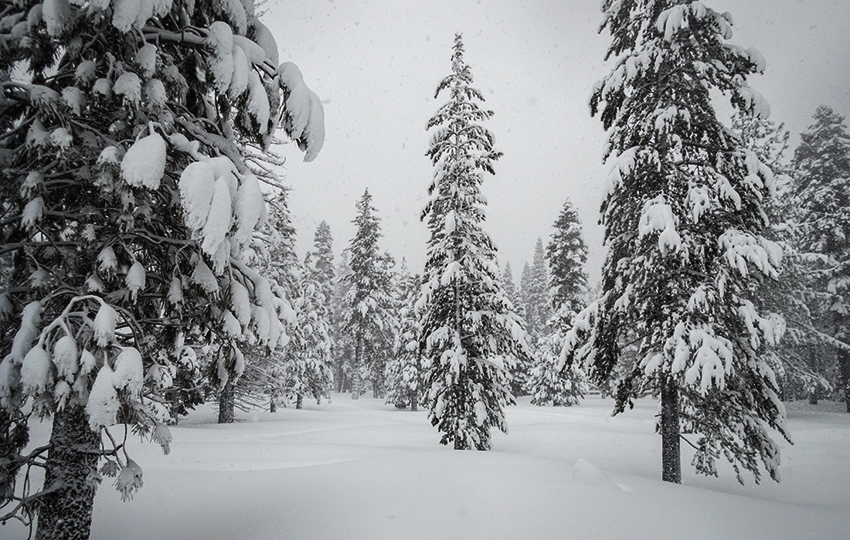
Without question, there are many ways in which to enjoy winter. There’s an entire snowsports industry dedicated to playing in the snow, after all. You could go downhill skiing, snowboarding, snowmobiling, snowshoeing, cross-country skiing, ice skating, or sledding. Although that’s an abridged list, you get the point. You have options during the winter for dealing with cabin fever!
With few exceptions, though, winter sports can actually be pretty expensive. This is particularly true when you’re just getting started. Purchasing new gear can be costly, especially if you’re looking for higher quality equipment. That said, cross-country ski gear may be more expensive than snowshoes but it’s far less expensive than alpine ski gear.
And depending on where you plan to play, access can be expensive. Just consider all of the costs associated with travel, lodging, parking, and day or season passes. Fortunately, you can cross-country ski nearly anywhere there’s snow so long as your destination is on public land and you can find safe parking.
Support Tahoe Trail Guide with a financial contribution via PayPal (single contribution) or Patreon (reoccurring contributions). Your support of Tahoe Trail Guide is very much appreciated!

Also, many winter sports require very specific environments in which to participate.
For example, an alpine ski resort employs lots of heavy machinery and infrastructure to maintain its groomed terrain and to keep the lift lines running. As a result, those types of activities attract numerous people. Basically, in order to do this thing you have to come to this place. So, you may find yourself being herded along with a thousand of your closest friends while participating in your sport of choice.
There are ideal conditions in which to cross-country ski, such as at groomed xc ski resorts. However, you can ultimately xc ski in a variety of locations that don’t require all of that infrastructure.
Now, I know there are ways in which to mitigate costs and avoid crowds during the winter. But often that whole process just winds up being a form of bargain shopping. You spend more time and energy dealing with commerce and crowds than actually having an immersive winter experience.
Planning and logistics are inherent to the outdoor experience. But wouldn’t it be more rewarding if they revolved around the weather and terrain rather than money and people?
Is Cross-Country Skiing the Best Winter Sport?
In all fairness, you could argue that any one of a number of snowsports are the “best” or most immersive winter activity. So it’s not my intention to convince you that cross-country skiing is the absolute greatest sport ever.
Rather, I’m going to discuss the concept of an immersive experience and just how immersive cross-country skiing can be when you see beyond its stereotypes and embrace the art in its entirety.
Again, I don’t do this at the expense of other snowsports. Cross-country skiing just happens to be my thing, so I’m framing my argument from that perspective. But when it comes down to it, I applaud your efforts to play outside during the winter regardless of your chosen activity.
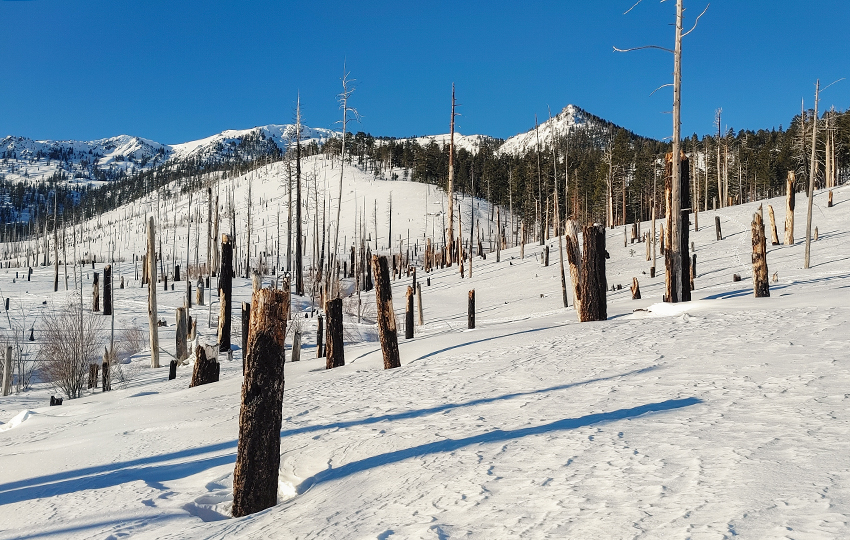
Stereotypes and Limiting Beliefs about Cross-Country Skiing
In spite of cross-country skiing’s rise in popularity over the last decade, it’s still the butt of many jokes. People who don’t xc ski look it and basically ask the question, “WHY?”
And this is often due to their association of cross-country skiing with stereotypes that are either unrelateble or lack the “coolness” factor of other snowsports.
For example, one prevalent stereotype is the spandex-clad twenty-something endurance athlete that collapses to the ground after sprinting across the finish line in sub-zero weather. Another is the little old lady shuffling across a meadow on a pair of xc skis that she bought back in 1978.
Or, people develop misguided beliefs about the sport because they don’t understand its potential.
For example, many people just treat cross-country skiing as filler, so they reduce it to one of the following activities.
- a novelty that they try once or twice each winter just to say they did it
- the replacement for the gym
- a sport in which they reluctantly participate while waiting for better weather so that they can do their more beloved sport
No offence to Nordic ski racers or your grandma. And, honestly, I can’t fault people for treating cross-country skiing as something to do in the meantime. This is because none of those stereotypes or beliefs are necessarily inaccurate or inherently bad. But they only make up a small fraction of cross-country skiing’s total experience.
There’s a wide range of options and opportunity along the cross-country skiing spectrum. And that range of potential is worth exploring if you have even the slightest interest in learning about xc skiing or just want to be outside more often in the winter.
Defining an Immersive Experience
To have an immersive experience is to have an open mind and be willing to accept what’s in front of you. That, and what’s behind, below, above, and around you! So, you can’t just be a passive observer. You also have to use your analytical and critical thinking skills while engaging in the experience.
Therefore, to fully immerse yourself in an experience you must observe and respond to the unique conditions with which you’re faced.
Imagine being in an hour-long classroom lecture. You could just sit there for the hour watching and listening to the teacher. Or you could watch and listen while taking notes, asking questions, participating in relevant discussions, offering answers to the instructor’s questions, and volunteering for hands-on demonstrations that the teacher employs to illustrate their lessons.
Honestly, having an immersive experience (as cool as that sounds) is not really unique or special. Ultimately, the essence of being immersed in an experience is to be engaged in life.
Unfortunately, many of us usually only engage when the situation absolutely demands it. Like when our home’s sewer main is clogged or our child gets into a fight at school.
Otherwise, many of us daydream during our commute to work. Or instead of having a meaningful conversation with our family while waiting to be served at a restaurant, for example, we just passively consume media on our phones. And, realistically, there are so many automated processes in our lives that we no longer need to put much effort into accomplishing certain things.
This isn’t to say that sending a text to our mother is so much less meaningful than writing a physical letter. Or, that using the dishwasher rather than washing our dishes by hand is a bad thing. However, it’s just very easy nowadays to take many of the things that used to be a production for granted. And that auto-pilot attitude can easily carry into other aspects of our lives.
I mean, “Isn’t there an app for that?”
So, the challenge to having immersive experiences is learning how to be present in the moment … always.
Cross-Country Skiing is the Definition of an Immersive Winter Experience
Even for many of us who live in snow country, winters are often just something to be endured. We catch glimpses of winter’s magic from the house or our cars while commuting to work. But unless we’re actively and consistently playing outside, we won’t experience winter on an intimate or immersive level. For that we need to explore the wilderness and experience the transformation of the snowpack, for example, directly underfoot.
Now, don’t get me wrong. Shoveling snow, driving in hazardous conditions, and dealing with power outages and frozen water pipes is definitely part of the winter experience. However, those struggles are just that – struggles. None of them offer much joy or deeper meaning.
Winter is challenging. Period.
But there’s so much fun and profound insight to be gained by looking beyond the typical rigors of winter. And cross-country skiing can help us achieve this in so many ways.
In many respects, I see cross-country skiing as its own language. So I treat the connection between technique (body) and technology (xc ski gear) with the environment (snow) as a conversation.
Some days those conversations are more meaningful than others, but they’re all conversations nonetheless. Therefore, the more fluent I can speak, the safer I can be, the more terrain I can access, and the more fun I can have.
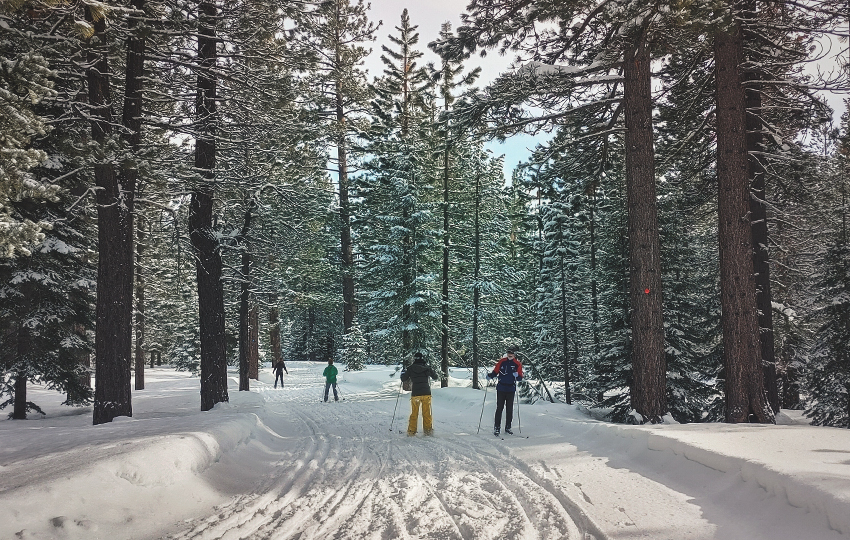
Cross-Country Ski Technique (Body)
Admittedly, what we’re attempting to accomplish when cross-country skiing is ludicrous. Whether we’re classic or skate skiing, we’re essentially balancing all of our weight on one leg at a time while sliding over uneven terrain.
So despite cross-country ski technique looking (at a glance) relatively easy to perform, the technique is deceptively complex. The movements appear similar to walking or running, but they’re not the same. And if you don’t understand positioning and movement and how those elements are supposed to work in harmony with the mechanics of the skis, you’re going to struggle.
That’s why there are so many jokes and limiting beliefs about cross-country skiing. Technique is far from being intuitive, so it doesn’t come easy to most people. The bottom lines is that learning good technique takes a long time. And most people just aren’t willing to invest the time necessary to become a better xc skier.
All of that said, I’d argue that there’s truly no right or wrong answer when it comes to going out on cross-country skis. You can definitely walk and shuffle around on them, which is why the entry barrier is relatively low to the sport. But to graduate from walking to actually diagonal striding, again, takes time and repetition.
So, instead, I’d say that there’s good and better technique. And when it’s only good, we should search for ways to do it better.
But what does better mean?
Better is more efficient so that you expend less effort and energy while xc skiing. Also, better is more effective meaning that every move you make enables you to travel forward. Ultimately, maintaining continuous forward motion, whether skiing uphill, downhill, or on the flats, is the ideal that we all seek to embody when cross-country skiing.
So, technique matters because the way we move our body directly affects our performance and, therefore, our overall experience.
Inherently, performing cross-country ski technique is immersive. This is because we have to constantly make the effort to set the grip zone during each push-off, for example, in order to maintain that forward momentum.
Remember, we’re on cross-country skis not snowshoes or alpine touring gear with full skins attached. So, we can’t take for granted that we’re going to move forward with every step we take. If we’re not intentional about this seemingly simple task of engaging the grip zone, we’re going to slip and slide everywhere. This, then, leads to excess fatigue on the body and low morale and possibly injury. And, of course, technique is made all the more challenging in variable snow conditions and/or while traveling uphill.
I wouldn’t say that this process is completely analytical, or that we’re always 100% conscious of every step we take. We are, after all, going to achieve some sort of flow state eventually when we’re skiing. But our experience should include periods of self-evaluation. We need to consider our positioning, movement, timing, and power output in the context of the snow and terrain over which we’re skiing.
Cross-country ski technique is dynamic and adaptable. And we need to modify the aforementioned elements in our technique (position, movement, timing, power) in order to efficiently and effectively ski uphill, downhill, and across the flats. And, again, this is made more challenging in variable snow conditions and over difficult terrain.
So while we’re actively participating in this conversation of traveling over snow, we should be “checking in” once and a while to make sure that all systems are still good to go.
Cross-Country Ski Technology (Gear)
By design, cross-country ski gear is lightweight and responsive. That’s so you can travel farther and faster and experience less fatigue on the body. And because the bindings of cross-country skis feature a free heel and the boots are exceptionally comfortable, we can move naturally.
So we can just walk or we can actually do diagonal stride technique. Again, there’s no right or wrong way only good and better. But these factors allow us to be more immersed in the outdoor experience because we’re not constantly focused on the struggle.
Make no mistake, though, you’re still going to get tired while cross-country skiing. But you’re essentially going to be able to ski twice as far with less effort in the same amount of time, for example, as it would take you to travel on snowshoes. That’s at least the case for backcountry travel. If we’re talking about cross-country skiing on groomed terrain, forget about it. You’ll be breaking land speed records compared to snowshoers so long as you know good xc ski technique!
Now, it’s probably a chicken and egg scenario whether or not technique was born out of technology or vice versa. But it doesn’t really matter. The important thing to note is that cross-country ski technique and the gear we run should work in harmony. So, as I previously stated, it’s imperative to understand the mechanics of cross-country ski gear in order to efficiently and effectively run our skis.
That said, I’m not going into detail about cross-country ski gear in this article. I’ve already written an entire in-depth series covering all of the major components of classic cross-country skiing. Furthermore, I’m not going to highlight the differences between classic and skate gear here either. Just know that classic technique and gear is far more complex than skate ski technique and gear. And this why it takes a lot longer to become a proficient classic skier in comparison.
The main points to know about classic xc ski gear, however, is that the skis feature both grip and glide zones. They also have a camber (or arc) to them so that the grip zones don’t constantly drag across the snow. But this camber requires us to put all of our body weight onto one ski in order to compress it flat so that the grip zone will engage with the snow. From there, we can push off to the next ski.
Again, this sounds very simple but it’s not easy to do when you’re first learning. It’s also more challenging to accomplish in variable snow conditions and difficult terrain. But once you start speaking this language of cross-country skiing, you’ll start worrying less about your gear which will allow you to focus more on navigating the terrain and experiencing the environment.
Lastly, because cross-country ski gear is inherently lightweight it does have its limitations. You can’t necessarily ski the same terrain as someone using alpine touring gear, for example. But I have seen some cross-country skiers pull off some pretty impressive feats. So, although the gear can be limiting it’s maybe not nearly as limiting as our own skills.
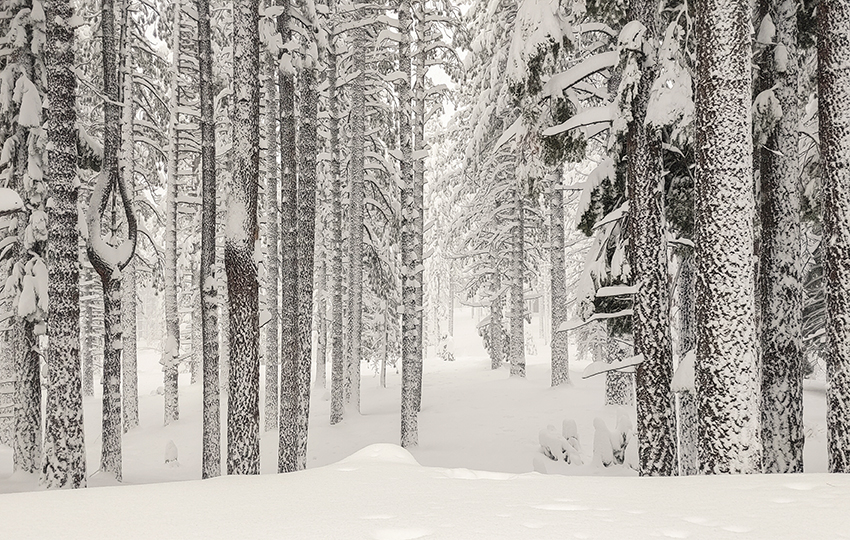
Cross-Country Ski Environments (Snow)
We control the first two aspects of an immersive cross-country skiing experience by developing our technique and learning about our gear. However, there’s not much we can do about the environment. We’re at the mercy of the snow, right?
But isn’t that kind of the point?
By knowing ourselves and our gear well enough, we can create a lot of opportunity and access to experience the great outdoors during the winter. Therefore, we can utilize any and all available terrain on which to cross-country ski.
For example, you could ski at groomed cross-country ski areas or you could take your skis off-trail and in the backcountry. Although both environments typically require slightly different gear, again, the cost of cross-country ski equipment is relatively affordable.
At groomed cross-country ski areas, there are no lift lines or queues in which to wait. Once you’re on the snow, you can just start skiing. And then after you’ve traveled a whopping quarter of a mile, you’re most likely going to be the only person on the trail at that point. That’s just how it is with cross-country skiing. Everyone skis at their own pace and it’s seldom going to be the same pace as yours.
Like I previously mentioned, so long as there’s snow on the ground we can ski on it. We don’t need steep terrain or super deep snow or a remote location or to spend the entire day skiing.
If all we have access to is a couple of inches of snow on the city park’s soccer field, so be it. Cross-country skiing was designed for flat terrain. In fact, I’ve practiced diagonal striding technique more times than I can count in the space of a few hundred meters of snow. And, believe it or not, I’ve managed to log over 5km in some of those shorter sessions by skiing back and forth so many times.
That soccer field session may not sound or look very sexy. But because cross-country skiing is so technical and aerobic, you could have a rewarding experience under those limited conditions. So this is why I wasn’t trying to poke too much fun at the grandma skiing across the meadow. Or, the people who treat cross-country skiing as a replacement workout. That’s because I occasionally treat cross-country skiing in a similar fashion.
I’m a technician, after all, so I constantly drill technique in controlled environments. This is so that when I’m faced with adverse conditions, I have the skills necessary to not only be safe but have some fun while I’m skiing.
Not every cross-country ski adventure is going to cover countless miles and last all day. Again, the cross-country ski experience is a broad spectrum so embrace it all.
Additionally, xc skiing allows us to directly feel the quality of snow change in various circumstances. For example, at different temperatures, elevations, and aspects of the wilderness. We’ll experience a dramatic change in snow quality when travelling from an open, south facing slope to a location that’s protected in the trees on the north side of a mountain. It’s critical that we pay close attention to these changes in snow conditions. This is so that we can adjust our technique accordingly. We’re trying to glide everywhere, after all, regardless of where we’re skiing (uphill, downhill, on the flats).
Then, as we continue to cross-country ski throughout the winter we’ll start to notice the changes in the overall snowpack. Back in November, for example, the first few snowstorms landed on warm, bare earth. As a result, the snow was likely to stick to our skis. But by January, the air temperature dropped and the snowpack persisted so new snow was probably colder and drier. And, finally, as spring rolled around and the temperatures became consistently higher each snowstorm yielded wet and sticky snow.
For me, experiencing this passage of time firsthand and in the context of the snowpack is one of the most rewarding and immersive aspects of cross-country skiing. As much as I’d love to discuss naturalism in greater detail and how I go about locating and identifying flora and fauna during the winter, however, I’ll save that topic for another day. Suffice it to say that this is all part of the immersive cross-country skiing experience.
Again, winter shouldn’t just be about shoveling and driving on icy roads. There’s an entire wonderland out there to embrace and explore.
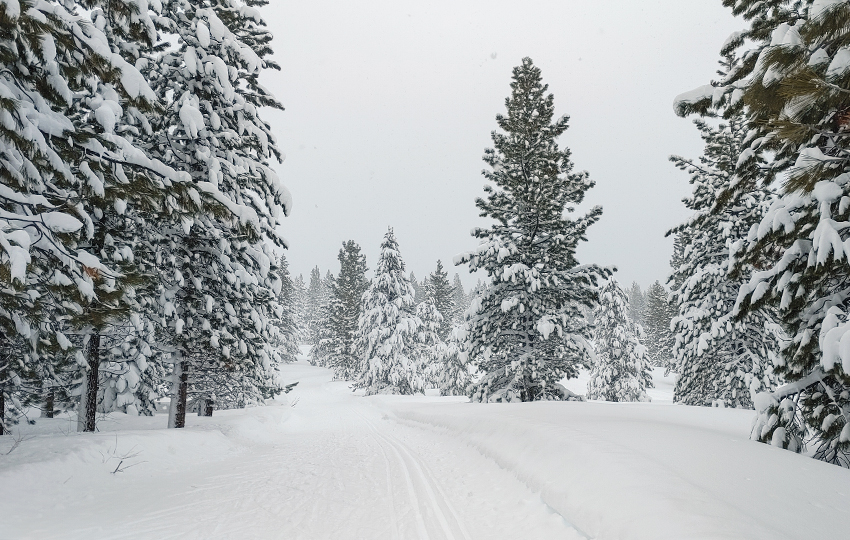
Final Thoughts
It may seem like the ultimate goal of cross-country skiing is to develop your skills so that you can effortlessly glide down the trail while enjoying nature’s beauty. And this would be true. But it would also be true that the ultimate goal is to be immersed in the cross-country ski experience regardless of how ideal it is. Furthermore, it’s true that becoming a proficient cross-country skier takes a long time.
We have to commit to a thing in order to reap its rewards. But if the ideal in which we seek is so far in the future, why bother at all?
Well, that’s for you to decide.
Some days you’ll spend all of your time evaluating your position and movement. Other days you’ll be frustrated with your skis because no matter what you do the snow keeps sticking to them. And then on other days, you’ll be absolutely enamored with the landscape. So there’s this spectrum of awareness starting with ourselves and our gear to that of nature. One aspect, however, is not necessarily better or more important than the other.
No matter where you are in the process of learning to cross-country ski, the immersive experience is available to you right now. It may not currently resemble what you consider to be the ideal scenario, but so long as you’re actively engaged in the experience you’re already there.
What do you do to create an immersive experience while cross-country skiing? Post your thoughts in the comment section below 🙂
Cross-Country Skiing Explained Articles and Videos
Please note that I wrote and produced the Cross-Country Skiing Explained series of articles and videos with the beginner and intermediate cross-country skier in mind. This is the demographic for whom I most often serve(d) while working in the outdoor recreation industry at Lake Tahoe. I basically treat these articles and videos as extensions of the conversations that I have (had) with those customers.
That said, expert skiers probably could take away something of value from these resources. Just know that I don’t address race-oriented philosophy, technique, or gear selection.
Considerations for buying cross-country ski gear (new and beginner xc skiers)
- Intention, Types of XC Skis, and Whether to Buy New or Used (Part 1)
- How Much Gear to Acquire, Evaluate Your Commitment, Value of Taking XC Ski Lessons (Part 2)
- Can One Set of Classic Cross-Country Skis Work for Groomed and Off-Track XC Skiing? (Part 3)
- Can I Use One Set of XC Ski Boots for All of My Cross-Country Skiing Needs? (Part 4)
- Overview of Off-Track and Backcountry Cross-Country Ski Gear
- Invest in Technique More than Gear
Classic Cross-Country Ski Components
- Introduction to Classic Cross-Country Skis (Part 1)
- Geometry of Classic Cross-Country Skis (Part 2)
- The Grip Zone of Classic Cross-Country Skis (Part 3)
- Types of Bindings for Classic Cross-Country Skiing (Part 4)
- Ski Boots for Classic Cross-Country Skiing (Part 5)
- Classic Cross-Country Ski Poles (Part 6)
- FAQs about Classic Cross-Country Skiing
Waxing Your “Waxless” Cross-Country Skis (for beginner and intermediate xc skiers)
- Introduction to Waxing Your Waxless XC Skis
- Step-by-Step Waxing Tutorial
- FAQs About Waxing Your Waxless XC Skis
Cross-Country Skiing Techniques, Demonstrations, and Related Concepts
- Outdoor VLOG (emphasis on the cross-country skiing experience)
- Cross-Country Skiing in Challenging Conditions
- Considerations for Winter Adventure in Lake Tahoe’s Backcountry
- Using the Side-Step and Herringbone Techniques in the Backcountry
- 10 Tips for Spring Cross-Country Skiing in the Backcountry
- 5 Reasons to Love Spring Cross-Country Skiing
- Considerations for Cross-Country Skiing During the Fall and Early Winter
- Discussing the Goal of Becoming a Better Cross-Country Skier and Embracing Backcountry and Groomed Terrain in Pursuit of that Goal
- The Cross-Country Skiing Experience: Immersing Yourself in Winter
Hello, Jared! Where is the comment section of https://tahoetrailguide.com/discussing-the-goal-of-becoming-a-better-cross-country-skier-and-embracing-backcountry-and-groomed-terrain-in-pursuit-of-that-goal/?
Hey Magnus!
I just checked and for some reason the feature to turn comments off after 28 days of the post’s publish date was enabled. I just disabled it, so you should be able to comment now.
Hope you’re doing well 🙂
I came back to nordic skiing after many years away. Back when I was 12 years old I was gifted a hand me down pair of skis and boots. Living in Vermont at the time on 20 acres of land and with countless snowmobile trails at my disposal I took to the snowy environment and traveled quite far distances, mostly alone and immersing myself in the wintry landscape. I had no technical training and just picked up a few things from my brother Steve so I was more or less as shuffling along but in my glory to be out. Fast forward to a couple years ago it was the same brother who convinced me to buy a setup as he had just gotten back into the sport and would love to ski with me. I purchased some skis boots and poles and took the the trails around his house. He taught me some technique but a lot of what I’ve learned I owe to your helpful instruction on YouTube. On the immersive quality of winter recreation, about seven years ago I started winter hiking. Being a landscaper by trade and snow plow driver in winter I often have free time in the winter months. Hiking in winter brought me a way to enjoy that free time in a productive and beautiful way. I tackled all 48 4k peaks in NH in a single winter season several years back and I became more comfortable in that environment. I also started winter backpacking, and then cue cross country skiing it sort of goes hand in hand with winter travel into the backcountry. My recent trip to Baxter State Park where I pulled a pulk in on my S Bound 98s was a proud moment of the culmination of all things winter recreation. I had to adapt to the terrain and switch to snowshoes when conditions proved too much effort and too steep on skis. More recently I pulled a pulk in with my 98s up a logging road in White Mountain National Forest and set up my hot tent near groomed terrain and was able to swap to Spider 62s and enjoy skiing in a groomed environment. This is all my own long winded way of highlighting the ways I immerse myself in the winter environment. And how nordic skiing has proved to add that additional layer to my winter experience. As always looking forward to more content and thank you for everything you do!
Wow! That’s quite the tale of cross-country skiing and outdoor adventure. I’m actually kind of jealous of all the adventures that you’ve had 🙂
Thanks so much for such a meaningful comment. I really appreciate you adding to the conversation. I’ve thought more than once over the past few years that I should dedicate one winter to mostly cross-country ski packing/winter overnights. I did a couple of them years ago and they were quite fun, but I also didn’t necessarily feel like my xc skiing skills were up to speed for some of the terrain that I was traveling. I’m a much more proficient skier now, so perhaps before the season is out I’ll give the winter camping another go. I suspect with all of the snow that we’ve received here in Tahoe, that spring would be an ideal time to get back out there. I remember you mentioning on YouTube the Baxter State Park experience. Again, very cool!
Back in the “recent” drought years of 2011-2015 (in Tahoe), I started winter hiking a lot. There just wasn’t much snow on which to do any kind of sliding sports and, at that time, I had all but given up on snowsports. That is, until my friend asked if I’d be interested in working for her at an xc ski resort during the holidays in that last drought winter to make some extra money (and help her out). I agreed, and I instantly fell in love with xc skiing. And I’ve been learning to become a better xc skier ever since.
I do appreciate how outdoor recreation can build and foster healthy relationships, and it sounds like you’ve had some great experiences with your brother.
Anyway, thanks again for the wonderful feedback and story! It motivates me to continue playing outside and to keep producing new content 🙂
Jared